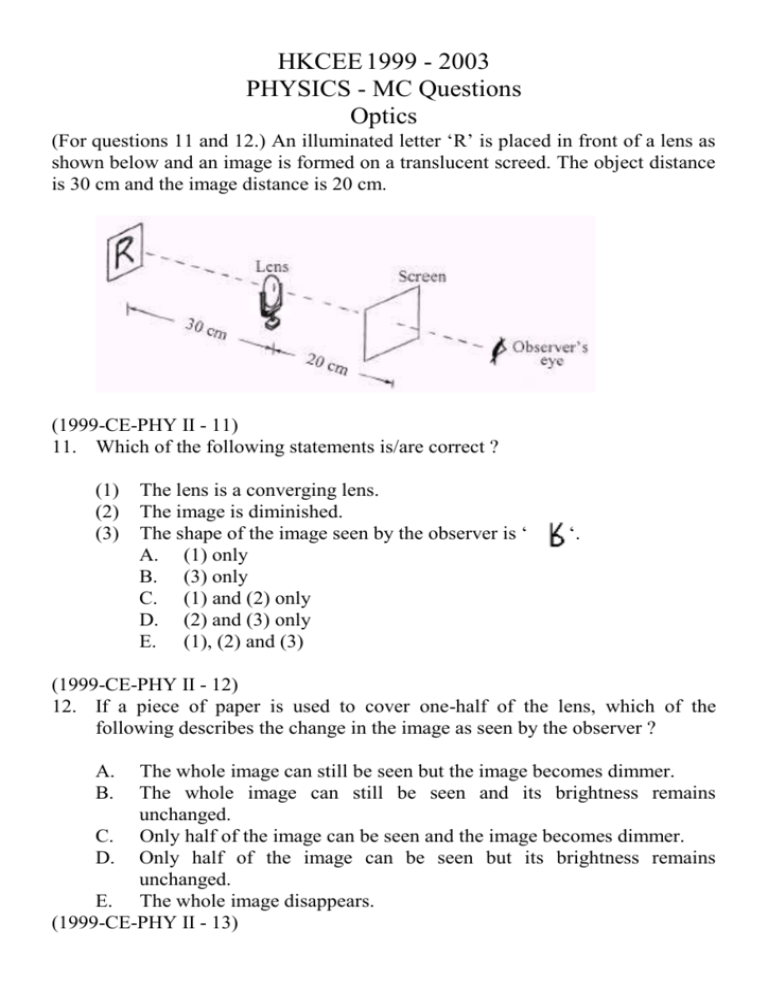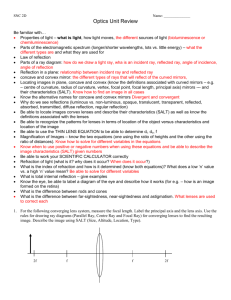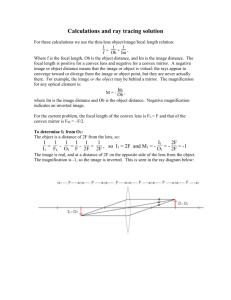ce-phy ii
advertisement

HKCEE 1999 - 2003 PHYSICS - MC Questions Optics (For questions 11 and 12.) An illuminated letter ‘R’ is placed in front of a lens as shown below and an image is formed on a translucent screed. The object distance is 30 cm and the image distance is 20 cm. (1999-CE-PHY II - 11) 11. Which of the following statements is/are correct ? (1) (2) (3) The lens is a converging lens. The image is diminished. The shape of the image seen by the observer is ‘ A. (1) only B. (3) only C. (1) and (2) only D. (2) and (3) only E. (1), (2) and (3) ‘. (1999-CE-PHY II - 12) 12. If a piece of paper is used to cover one-half of the lens, which of the following describes the change in the image as seen by the observer ? A. B. The whole image can still be seen but the image becomes dimmer. The whole image can still be seen and its brightness remains unchanged. C. Only half of the image can be seen and the image becomes dimmer. D. Only half of the image can be seen but its brightness remains unchanged. E. The whole image disappears. (1999-CE-PHY II - 13) 13. A ray of light travels in air and strikes a rectangular glass block at an angle of incidence 50°. The critical angle of the glass is 42°. Which of the following diagrams best shows the path of the ray ? (1999-CE-PHY II - 14) 14. Which of the following is not a correct application of the corresponding optical device ? Optical device A. B. C. D. E. Application Triangular prisms Periscopes Concave mirrors Shaving mirrors Convex mirrors Used in supermarkets to guard against shoplifters Concave lenses Magnifying glasses Convex lenses Spectacles for correcting long sight (1999-CE-PHY II - 15) 15. Which of the following statements concerning virtual images is/are correct ? (1) (2) (3) Virtual images are always diminished. Virtual images can be photographed with a camera. Virtual images cannot be formed on a screen. A. B. C. D. E. (1) only (3) only (1) and (2) only (2) and (3) only (1), (2) and (3) (2000-CE-PHY II - 13) 13. Which of the following optical devices can be used to focus sunlight on a match and set it on fire ? (1) (2) (3) a magnifying glass the parabolic mirror of an electric torch a spectacle lens used for correcting long-sightedness A. B. C. D. E. (1) only (3) only (1) and (2) only (2) and (3) only (1), (2) and (3) (2000-CE-PHY II - 14) 14. An object is placed in front of a mirror M and an image is formed as shown above. What type of mirror is M and what is its focal length ? A. B. C. D. E. Type of mirror convex convex concave concave concave Focal length 20 cm 40 cm 20 cm 40 cm 80 cm (2000-CE-PHY II - 15) 15. F and F` are the foci of the above lens and AB is an incident ray. Which of the following paths best represents the emergent ray ? A. B. C. D. E. P Q R S T (2000-CE-PHY II - 16) 16. A ray of light enters a glass prism and travels along the path as shown above. Find the refractive index of the glass. A. B. C. D. E. 0.68 1.07 1.37 1.47 1.50 (2000-CE-PHY II - 17) 17. A student uses a single-lens camera to take a photograph of two books. The photograph turns out to be blurred as shown in Figure (a). Which of the following changes can enable the student to take a sharp photograph of the books at the same location (see Figure (b)) ? (1) (2) (3) using a flash in taking the photograph replacing the lens of the camera by another one of longer focal length adjusting the distance between the lens and the film A. B. C. D. E. (1) only (3) only (1) and (2) only (2) and (3) only (1), (2) and (3) (2000-CE-PHY II - 18) 18. A student uses two triangular prisms to construct a periscope as shown above. Which of the following shows the image of the object as seen by the observer ? A. B. C. D. E. (2001-CE-PHY II - 13) 13. Which of the following images in the photographs is/are virtual ? (1) (3) the image on the screen in a cinema the image on the surface of a pool of calm water (2) the image in a security mirror in a supermarket A. B. C. D. E. (1) only (3) only (1) and (2) only (2) and (3) only (1), (2) and (3) (2001-CE-PHY II - 14) 14. Two parallel rays from a distant object strike a concave mirror as shown above, where F is the focus. At which of the following points does the image of the object form ? A. B. C. D. E. P Q R S T (2001-CE-PHY II - 15) 15. An object is placed in front of a curved mirror and an image is formed as shown above. Which of the following describes the type of mirror being used and the nature of the image formed ? A. B. C. D. E. Mirror convex convex concave concave concave Image real and formed in front of the mirror virtual and formed behind the mirror real and formed in front of the mirror real and formed behind the mirror virtual and formed behind the mirror (2002-CE-PHY II - 13) 13. A microwave receiver is installed in front of concave reflector. At which position should the receiver be installed in order to ensure the best reception of microwaves? A. at the center of curvature of the reflector B. at the focus of the reflector C. at the pole of the reflector D. at the mid-point between the pole and the focus of the reflector (2002-CE-PHY II - 14) 14. A ray of light travels in air and strikes a glass block as shown above. Which of the following diagrams best shows the path of the ray? (2002-CE-PHY II - 15) 15. Which of the following statements about the properties of virtual images formed in spherical mirrors is incorrect? A. Virtual images can be seen by observers. B. Virtual images always lie behind the mirror. C. Virtual images are always erect. D. Virtual images are always magnified. (2002-CE-PHY II - 16) 16. A man places his spectacles on a book as shown above. What kind of lenses does he wear and what defect of vision does he have? Lenses Defect of vision A. converging lenses long-sightedness B. converging short-sightedness C. diverging lenses D. diverging lenses lenses long-sightedness short-sightedness (For Questions 17 and 18.) A cup is placed in front of a window, outside which is a distant building. Two photos P1 and P2 as shown below are taken with the same single-lens camera. (2002-CE-PHY II - 17) 17. Which of the following ray diagrams correctly shows how the image I of the cup O is formed by the lens of the camera in photo P1? 18. (2002-CE-PHY II - 18) 18. Which of the following statements about the two photos must be correct? A. In P1, the images of the cup and the building are on different sides of the lens of the camera. B. In P1, the image of the cup is real while that of the building is virtual. C. On taking P2, the distance between the lens and the film of the camera is shorter than that on taking P1. D. After taking P1, the photographer has to move forward in order to take P2. (2003-CE-PHY II - 13) 13. A ray of light travels in air and strikes a glass prism as shown above. Which of the following diagrams best shows the path of ray? (2003-CE-PHY II - 14) 14.Which of the following mirrors can be used as rear-view driving mirrors? (1) plane mirrors (2) concave mirrors (3) convex mirrors A. B. C. D. (2) only (3) only (1) and (2) only (1) and (3) only (2003-CE-PHY II - 15) 15. Which of the following ray diagrams concerning the refraction of light ray by a converging lens is/are incorrect? F denotes the focus of the lens. A B C. D. (2) only (3) only (1) and (2) only (1) and (3) only (2003-CE-PHY II - 16) 16 The photograph shows a student using a magnifying glass of focal length 20 cm to view a distant object. Which of the following statements about the image formed is/are correct? (1) The image will be erect. (2) The image will be diminished. (3) The student must use a screen in order to see the image. A. B. C. D. (1) only (2) only (1) and (3) only (2) and (3) only (2003-CE-PHY II - 17) 17. The photograph shows the image of a car formed in a mirror which helps drivers to view traffic conditions. Which of the following describes the type of mirror being used and the nature of the image? Type of mirror A concave B concave C convex D convex Nature of image real virtual real virtual (2003-CE-PHY II - 18) 18. Amy uses a single-lens camera to take a photograph of a monument (see Figure (a)). Which of the following adjustments to I. The distance between the monument and the camera lens, and II. The distance between the camera lens and the film, can enable Amy to take another photograph as shown in Figure(b)? I A B C D an increase an increase A decrease A decrease II a decrease no change a decrease no change






